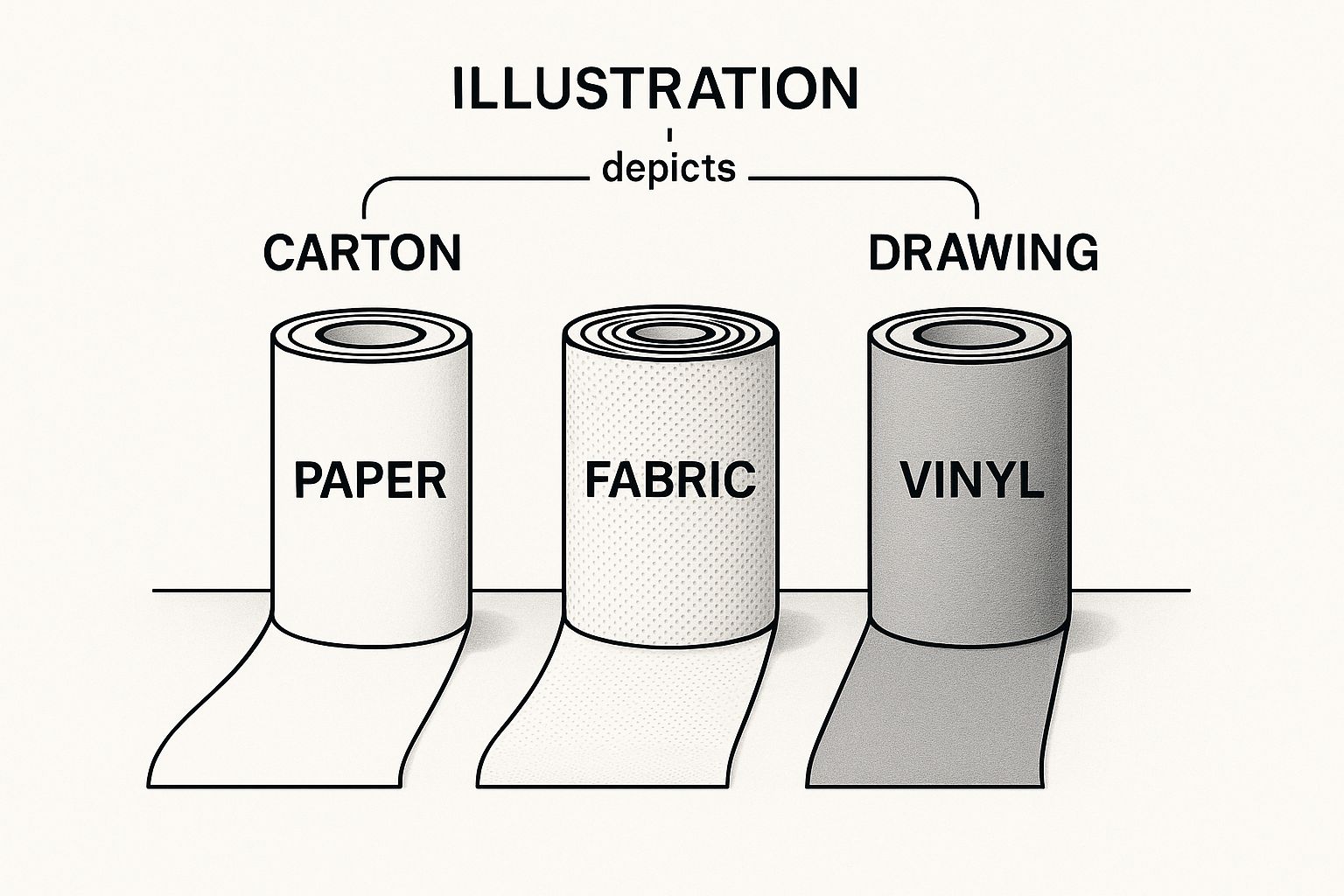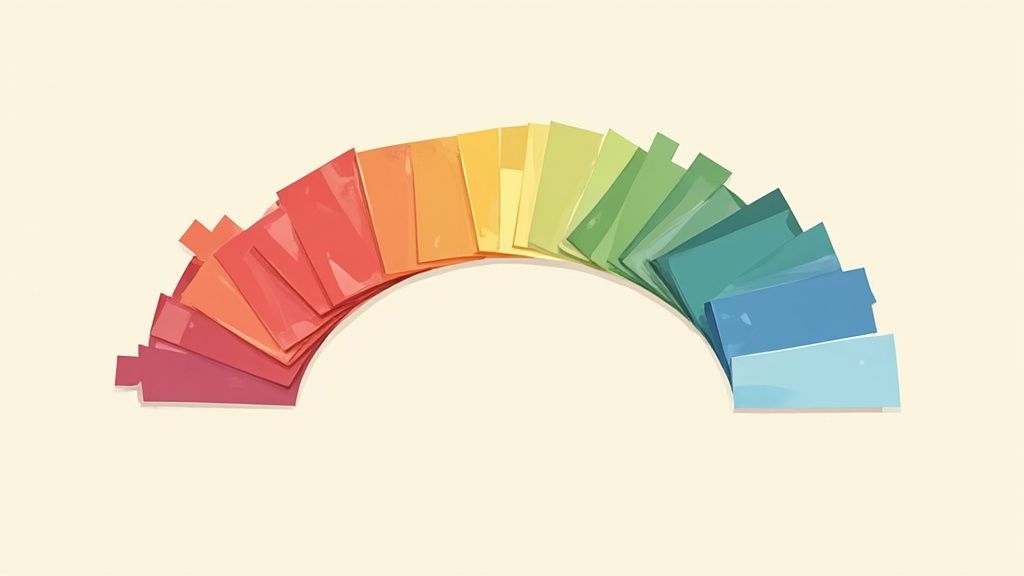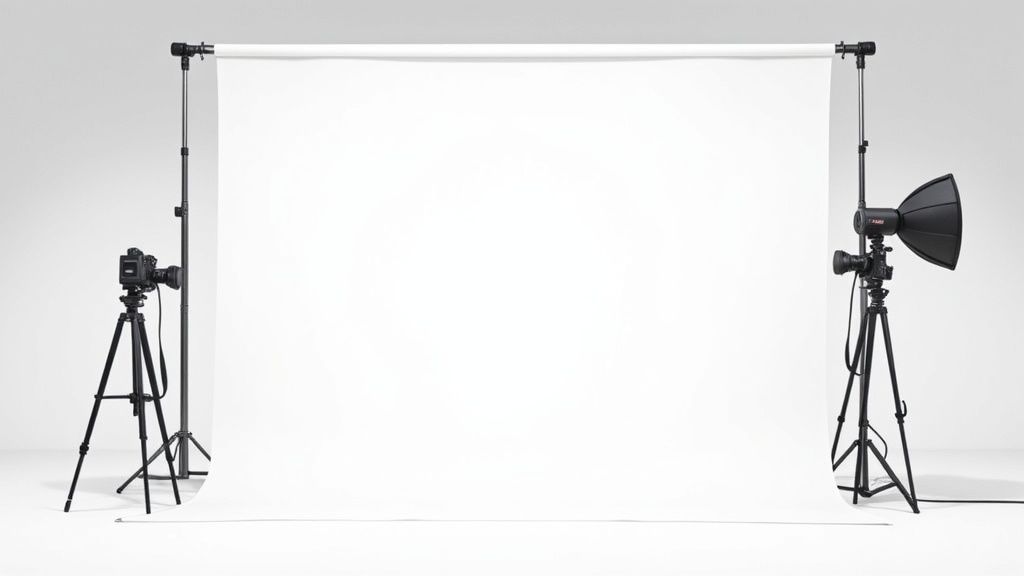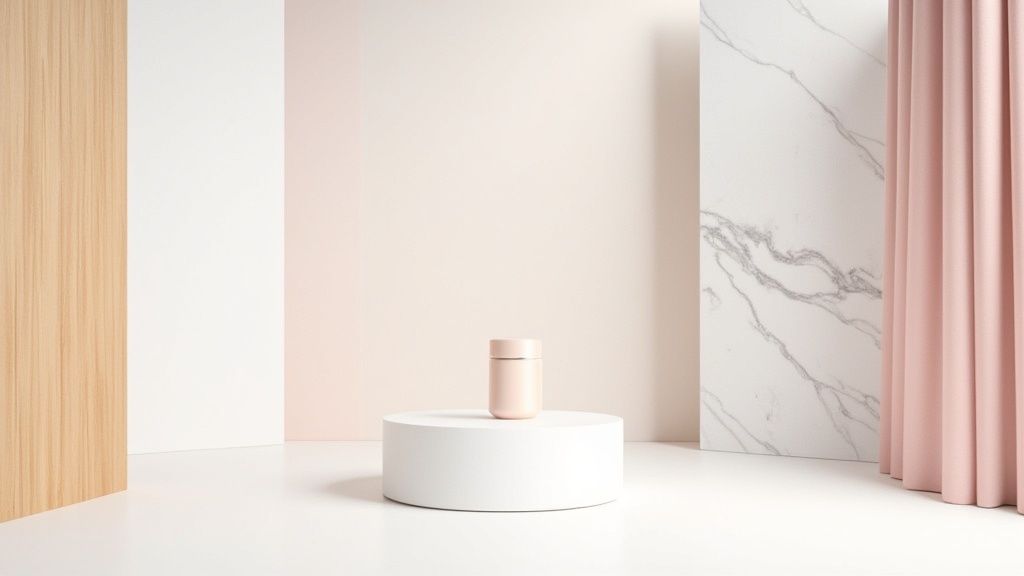So, what exactly is a product photography backdrop? Think of it as the stage where your product is the star of the show. It’s the surface or material you place behind an item to create a clean, professional, and uncluttered background for your photos. Its entire job is to help define the product's context, set a mood, and boost its perceived value—all while making sure the product itself is the hero of the image.
Why Your Backdrop Is a Silent Salesperson
If your product is the star, the backdrop is the stage—it provides context, sets the right mood, and makes your star shine brighter than ever. A well-chosen product photography backdrop can be a total game-changer for e-commerce brands, turning an everyday item into something people have to own. It's more than just a background; it's a strategic tool for creating images that actually sell.
The right choice can strengthen your brand’s identity and drive sales. The wrong one? It can distract customers and make your entire brand feel cheap.
The growing demand for high-quality visuals isn't just a gut feeling; it’s a booming market. The photography props industry is projected to hit a market size of around $500 million in 2025 and is expected to grow at an annual rate of 7% through 2033. This surge is largely fueled by social media, where professional-looking images are no longer a luxury but a necessity. You can find more details on this trend over at Archive Market Research.
The Strategic Role of a Backdrop
A professional backdrop does way more than just fill the empty space behind your product. It’s actively working to make your photos more effective. Here’s how:
- It Kills Distractions: A clean, simple background forces the customer’s eye right where you want it: on your product. It highlights features and quality without any visual noise.
- It Builds Your Brand Identity: The color, texture, and style of your backdrop are powerful communicators. A sleek black surface whispers luxury, while a rustic wood background gives off a natural, handmade vibe.
- It Creates Visual Consistency: Using the same or similar backdrops across your entire store creates a cohesive, professional look. This consistency builds trust and makes your brand instantly recognizable.
A great product photography backdrop doesn't just support the product—it elevates it. It silently communicates quality and professionalism, making the customer feel more confident in their purchase decision before they even read the description.
Of course, a great backdrop is just one piece of the puzzle. To really nail your visuals, you need to master the bigger picture. For more great advice, check out these effective ecommerce photography tips.
Choosing the Right Backdrop Material
The material you choose for your product photography backdrop does more than just fill the space behind your product—it completely sets the scene. It's the unsung hero that influences texture, light, and the overall vibe of your final shot.
Get it right, and your product pops. Get it wrong, and you could spend hours in post-production trying to fix a simple glare or an unwanted wrinkle.
Let’s walk through the most common materials—paper, vinyl, fabric, and natural surfaces—to figure out which one is the perfect fit for your studio.
Seamless Paper Backdrops
Ask any studio photographer what their go-to backdrop is, and they'll likely point to a rack of seamless paper rolls. There's a good reason for this. They provide a perfectly smooth, clean, and uniform background that puts all the focus squarely on your product.
With over 50 color options typically available, finding a shade that matches your brand's aesthetic is a breeze. They're fantastic for creating that crisp, professional look you see in high-end e-commerce stores.
- Pros: Flawlessly smooth finish, huge color variety, and generally affordable.
- Cons: Can crease or tear easily, and once a section gets dirty, you pretty much have to tear it off and roll out a new piece.
Think of seamless paper as your workhorse for clean, consistent product shots where the background needs to be perfectly unobtrusive.
Vinyl Backdrops
If you're shooting anything that might splash, spill, or get messy, vinyl is your best friend. This stuff is tough.
Vinyl backdrops are built to last, easily wiping clean from spills and resisting scuffs and scratches. This makes them an absolute lifesaver for food photography, cosmetic shots, or any project involving liquids or powders.
- Pros: Waterproof, incredibly durable, and super low maintenance.
- Cons: The surface can be a bit reflective, which can cause unwanted glare if your lighting isn't set up just right.
While you have to be mindful of that potential shine, the durability and reusability of vinyl make it an invaluable tool for messier shoots.

Backdrop Material Comparison Guide
Feeling a bit overwhelmed by the options? Don't worry. This quick-glance table breaks down the key differences to help you zero in on the best material for your specific needs.
| Material | Best For | Pros | Cons |
|---|---|---|---|
| Seamless Paper | Crisp studio shots, e-commerce, portraits | Smooth surface, wide color variety, affordable | Tears easily, single-use segments |
| Vinyl | Food, cosmetics, messy or wet setups | Waterproof, highly durable, easy to clean | Can be reflective and cause glare |
| Fabric | Lifestyle shots, apparel, soft-focus looks | Reusable, adds texture, drapes and folds well | Wrinkles easily, can be difficult to clean spots |
| Natural Surfaces | High-end goods, moody setups, artisanal crafts | Rich, authentic texture, premium feel | Heavy, expensive, and not very portable |
Use this as your starting point, but remember that the best way to find your favorite is to experiment with a few different types.
Fabric Backdrops
When you want to add a touch of softness, depth, or a cozy, lifestyle feel to your photos, fabric is the way to go. Materials like cotton and muslin are popular choices because they drape beautifully and absorb light, which helps minimize glare.
They’re easy to fold up, transport, and clip onto a stand, making them great for on-location shoots.
- Pros: Adds a soft, tactile quality, often machine washable, and very reusable.
- Cons: Wrinkles are a constant battle (keep a steamer handy!), and colors can fade over time with washing.
Fabric is perfect for apparel, home goods, or any product that benefits from a more organic, textured setting.
Natural Surface Backdrops
For a truly authentic, high-end look, nothing beats the real thing. Natural surfaces like slabs of wood, marble, stone, or even concrete bring an unmatched level of texture and character to an image.
These backdrops are perfect for artisanal crafts, luxury goods, or any product where you want the background to feel as premium as the item itself.
- Pros: Incredible, rich texture and a genuinely premium appearance.
- Cons: They are often extremely heavy, expensive, and not something you can easily move around.
While the weight and cost can be a barrier, the stunning visual payoff is often worth it for creating those jaw-dropping, moody shots. And if you're on a budget but feeling crafty, you can always learn to create your own backdrops for a more personalized touch.
Using Color to Influence Your Customers
Think of your product photography backdrop's color as the soundtrack to a movie. It's playing in the background, sure, but it has the power to make your audience feel a jolt of excitement, a sense of trust, or a touch of luxury. That simple color choice is one of the most powerful tools you have for telling your brand’s story and shaping how customers see your product.
Color psychology isn't some abstract theory; it's a very real sales tool. For instance, there's a reason a crisp, pure white backdrop is the gold standard for marketplaces like Amazon. It signals cleanliness and simplicity, stripping away all distractions so the product is the undeniable hero of the shot. It’s the perfect setup for a straightforward, trustworthy shopping experience.
On the flip side, a deep black backdrop can instantly scream sophistication and high value. It’s a go-to for luxury items like watches, high-end electronics, or premium spirits because it dials up the drama and exclusivity, making the product feel more important.

The Power of Neutrals and Vibrants
Beyond the classic black and white, neutral gray is probably the most versatile color in a photographer’s entire toolkit. It creates a modern, balanced canvas that lets your product’s colors pop without ever trying to steal the show. Gray is the ultimate team player, easily adapting to almost any product or brand style you throw at it.
But what if your brand is all about energy and personality? That's when vibrant colors are your best friend. A bold yellow or an electric blue backdrop can stop scrollers dead in their tracks and broadcast a fun, youthful vibe. Soft pastels, on the other hand, create a gentle, inviting feeling that’s ideal for baby products, skincare, or handmade goods. The right shade helps you connect with your ideal customer on an emotional level.
Your backdrop color should be a deliberate choice that reinforces your brand's core message. It’s not just about what looks good; it’s about what feels right for the story you’re trying to tell.
Matching Color to Brand Identity
The trick is to land on a color palette that makes your product look fantastic while staying true to your brand. For example, a company focused on natural, organic products would be wise to use earthy tones like beige, olive green, or muted browns. These colors subconsciously telegraph a connection to nature and authenticity.
As the photography market changes, so do trends in colors and materials. We're seeing a rise in eco-friendly backdrops made from recycled or biodegradable materials, which lines up perfectly with a growing consumer focus on sustainability. This is all part of a bigger market shift, with the global photography industry expected to grow from $105.2 billion in 2025 to $161.8 billion by 2030.
Ultimately, the goal is to make your product photography look cohesive and intentional. While the perfect color can make an image sing, minor imperfections can always be polished up in post-production. To learn more about getting that flawless final look, check out our guide on professional product photo editing services.
Mastering Your Backdrop Setup and Lighting
Having the perfect product photography backdrop is a great start, but the real magic happens when you set it up and light it just right. A flawless, professional-looking image hinges on getting a smooth, wrinkle-free surface and using intentional lighting that makes your product the undeniable hero.
The first job is to secure your backdrop properly. It doesn't matter if you're using seamless paper, vinyl, or fabric—a dedicated stand with a good set of clamps is non-negotiable. This setup is what lets you create that gentle curve, or "sweep," from the wall to the floor, which completely erases the harsh horizon line that can ruin a shot. Use your clamps generously along the top bar to pull the material taut, getting rid of any distracting waves or sags.
How to Light Your Backdrop Like a Pro
Once your backdrop is perfectly smooth, it's time to light it. Here's a pro-level technique that gives you total control: light your backdrop and your product separately. This separation is the secret behind those clean, high-end commercial images and stops your product from casting ugly shadows onto the background.
For that pure white background so many e-commerce platforms demand, you need to light the backdrop evenly and brightly. The trick is to place one or two lights aimed directly at the backdrop, positioned behind your product and safely out of the camera's view.
The goal is to overexpose the white backdrop just enough so it becomes pure white (RGB 255, 255, 255) without letting that light spill onto your product and wash out its details. Getting this right will save you countless hours of tedious editing later.
On the flip side, if you're going for a dramatic black or a rich colored backdrop, you want to do the exact opposite and prevent light from hitting it. Use flags (just simple black cards) or grids on your lights to carefully control where the light goes, ensuring the background stays deep and saturated. This contrast makes your product pop right off the screen.
Creating Depth with Gradients and Shadows
A flat, evenly lit backdrop isn't your only play. You can add a ton of depth and a premium feel to your images by creating a subtle gradient. By placing a single light with a snoot or grid behind your product and aiming it at the backdrop, you can create a soft halo of light. This simple effect immediately draws the viewer's eye right where you want it: on the product.
The world of photography backdrops is always changing, driven by the demand for more specialized and creative options. In fact, today around 80% of suppliers offer customizable backdrops to meet very specific needs. This trend also shows a preference for durable materials like PVC and ABS, which are perfect for tricky subjects like food and jewelry because they're waterproof. You can learn more about these trends in photography backgrounds and see what's on the horizon.
Mastering these setup and lighting techniques is what separates a simple product photo from a compelling, professional image—the kind that stops a customer from scrolling and gets them to click "add to cart."
Common Backdrop Mistakes and How to Fix Them
Even with the perfect product photography backdrop, a few common slip-ups can sabotage all your hard work. Catching and fixing these issues before you start shooting is the secret to getting that professional finish—and it'll save you from hours of headaches in post-production.
Let's break down the most common culprits and how to deal with them.
Dealing with Wrinkles and Creases
Nothing screams "amateur" quite like a wrinkled fabric backdrop. Every little fold and crease casts a shadow, creating a busy pattern that pulls the eye away from your product.

While steaming or ironing is always your best bet, sometimes you need a quick fix on set. Try pulling the fabric as tight as you can, using extra clamps on your stand to stretch it out. You can also play with your lighting—moving your main light further away can soften the shadows from minor wrinkles, making them almost disappear.
The best defense is a good offense. Always store your fabric or paper backdrops rolled up, never folded. This one simple habit will prevent those stubborn creases from ever forming.
Avoiding Distracting Textures and Reflections
Textured backdrops like wood or marble can add a ton of character, but they should never steal the show. If the texture is too "busy," it starts competing with your product for attention.
To fix this, grab a lens with a wider aperture (like an f/2.8) to create a shallow depth of field. This will gently blur the background, making your product pop right off the screen.
When you're working with glossy backdrops like vinyl or acrylic, reflections are the real enemy. The trick is to carefully manage your light. A large, diffused light source, like a softbox, will create softer, more flattering highlights. You can also place black cards just out of the frame to soak up any stray light and kill that unwanted glare.
Preventing Unwanted Color Casts
Ever taken a photo where your "pure white" backdrop looks a little blue or yellow? That's a color cast, and it's usually caused by mixing different light sources or having the wrong white balance setting on your camera.
The fix is surprisingly simple: turn off all the other lights in the room. Just use your main studio lights.
Next, set a custom white balance on your camera using a gray card. This tells your camera exactly what "neutral" looks like in your current lighting, guaranteeing your colors are spot-on. Sure, you can try to fix it later, but getting it right in-camera is always better. If a background gets too messy to salvage, knowing how to remove a background for a Shopify product can be a real lifesaver.
Sizing Your Backdrop for Perfect Shots
Choosing the right backdrop size is a bit like getting a suit tailored. If the fit is off, the whole look just falls apart.
Go too small, and the edges of your setup will start creeping into the frame. This creates a messy, unprofessional shot that you'll have to spend ages trying to fix in editing. But go too large, and you're just wasting money on material you'll never use. The real secret is matching the scale of your backdrop to the scale of your product.
Think of it this way: your backdrop needs to be significantly larger than your subject to create that clean, edgeless world we're after.
A solid rule of thumb is to pick a backdrop that's at least twice the width and twice the height of your biggest product. This gives you plenty of breathing room around the item, prevents the composition from feeling cramped, and gives you the freedom to try different camera angles.
Matching Size to Subject
For small items like jewelry, makeup, or little gadgets, a simple tabletop setup is all you need. A backdrop around 24 x 24 inches is usually perfect for this. It’s large enough to create that seamless "infinity sweep"—where the background curves smoothly from the vertical wall to the floor—and gets rid of any distracting horizon lines.
When you graduate to medium-sized products like shoes, handbags, or small home decor, you'll need a bit more space. Backdrops in the 53-inch wide range are a super popular choice here. They provide plenty of coverage for a whole variety of products without completely taking over your room.
For the big stuff—think furniture or apparel on a mannequin—you’ll need to bring out the big guns. A full-sized seamless paper roll, often 107 inches wide, is essential. This scale is what you need to create a clean, expansive background that makes the product the one and only star of the show.
Getting the size right from the start means your final images will look clean and professional, ready for any platform. And if you find later that you need to tweak them for different marketplace specs, you can easily use an online image resizer tool to get the perfect fit.
Got a Few Questions?
Once you dive into the world of backdrops, a few practical questions always seem to pop up. Whether you're setting up your first home studio or just trying to get more life out of your gear, here are some quick answers to the most common queries we hear.
How Do I Clean My Backdrop?
The right way to clean your backdrop really boils down to what it's made of.
For a tough vinyl backdrop, a simple wipe-down with a damp cloth is usually all you need to handle dust or minor spills. Easy.
Fabric backdrops, like muslin, can often be tossed in the washing machine on a gentle cycle. But it's always a good idea to check what the manufacturer recommends first, just to be safe.
Seamless paper is a different beast entirely. Since you can't wash it, you have to get a little creative. You can sometimes buff out small scuffs with a clean pencil eraser. If you've got a bigger stain or a tear, the best move is to simply cut off the dirty section and pull down a fresh, clean sheet for your next shoot.
Can I Iron or Steam My Backdrop?
Wrinkles are the absolute enemy of a clean, professional shot. The good news is, yes, you can usually get them out with a bit of heat.
A handheld steamer is your best friend for most fabric backdrops. It’s gentle, effective, and relaxes the fibers without the harsh, direct heat of an iron.
If you absolutely have to use an iron, turn it to its lowest heat setting. CRITICAL: always place a thin cloth, like a pillowcase, between the iron and the backdrop to avoid scorching or melting the material. And never, ever use an iron on vinyl or paper backdrops—it will ruin them instantly.
Here's a pro-tip that will save you a ton of hassle: proper storage is the best wrinkle prevention. Always roll your backdrops, never fold them. This one simple habit keeps deep creases from forming in the first place, especially for seamless paper and vinyl.
Ready to create stunning, studio-quality images without all the setup? ProdShot uses AI to instantly transform your simple product photos into professional, conversion-ready visuals. Get your free trial and see the magic for yourself.

